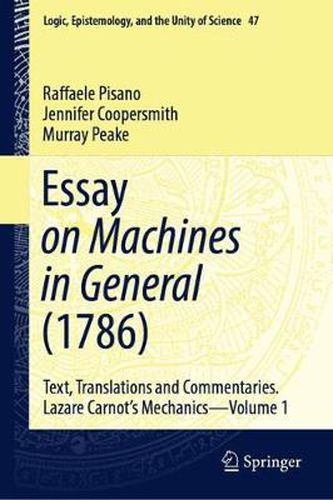Readings Newsletter
Become a Readings Member to make your shopping experience even easier.
Sign in or sign up for free!
You’re not far away from qualifying for FREE standard shipping within Australia
You’ve qualified for FREE standard shipping within Australia
The cart is loading…






This title is printed to order. This book may have been self-published. If so, we cannot guarantee the quality of the content. In the main most books will have gone through the editing process however some may not. We therefore suggest that you be aware of this before ordering this book. If in doubt check either the author or publisher’s details as we are unable to accept any returns unless they are faulty. Please contact us if you have any questions.
This book offers insights relevant to modern history and epistemology of physics,
mathematics and, indeed, to all the sciences and engineering disciplines emerging
of 19th century. This research volume is the first of a set of three Springer books on
Lazare Nicolas Marguerite Carnot’s (1753-1823) remarkable work: Essay on Machines in
General (Essai sur les machines en general [1783] 1786). The other two forthcoming
volumes are: Principes fondamentaux de l'equilibre et du mouvement (1803) and
Geometrie de position (1803).
Lazare Carnot - l'organisateur de la victoire - in Essai sur le machine en general (1786)
assumed that the generalization of machines was a necessity for society and its economic
development. Subsequently, his new coming science applied to machines attracted
considerable interest for technician, as well, already in the 1780’s. With no lack in
rigour, Carnot used geometric and trigonometric rather than algebraic arguments, and
usually went on to explain in words what the formulae contained. His main physical-
mathematical concepts were the Geometric motion and Moment of activity-concept of
Work . In particular, he found the invariants of the transmission of motion (by stating
the principle of the moment of the quantity of motion) and theorized the condition of
the maximum efficiency of mechanical machines (i.e., principle of continuity in the
transmission of power).
While the core theme remains the theories and historical studies of the text, the book
contains an extensive Introduction and an accurate critical English Translation -
including the parallel text edition and substantive critical/explicative notes - of Essai
sur les machines en general (1786). The authors offer much-needed insight into the
relation between mechanics, mathematics and engineering from a conceptual, empirical
and methodological, and universalis point of view. As a cutting-edge writing by
leading authorities on the history of physics and mathematics, and epistemological
aspects, it appeals to historians, epistemologist-philosophers and scientists (physicists,
mathematicians and applied sciences and technology).
$9.00 standard shipping within Australia
FREE standard shipping within Australia for orders over $100.00
Express & International shipping calculated at checkout
This title is printed to order. This book may have been self-published. If so, we cannot guarantee the quality of the content. In the main most books will have gone through the editing process however some may not. We therefore suggest that you be aware of this before ordering this book. If in doubt check either the author or publisher’s details as we are unable to accept any returns unless they are faulty. Please contact us if you have any questions.
This book offers insights relevant to modern history and epistemology of physics,
mathematics and, indeed, to all the sciences and engineering disciplines emerging
of 19th century. This research volume is the first of a set of three Springer books on
Lazare Nicolas Marguerite Carnot’s (1753-1823) remarkable work: Essay on Machines in
General (Essai sur les machines en general [1783] 1786). The other two forthcoming
volumes are: Principes fondamentaux de l'equilibre et du mouvement (1803) and
Geometrie de position (1803).
Lazare Carnot - l'organisateur de la victoire - in Essai sur le machine en general (1786)
assumed that the generalization of machines was a necessity for society and its economic
development. Subsequently, his new coming science applied to machines attracted
considerable interest for technician, as well, already in the 1780’s. With no lack in
rigour, Carnot used geometric and trigonometric rather than algebraic arguments, and
usually went on to explain in words what the formulae contained. His main physical-
mathematical concepts were the Geometric motion and Moment of activity-concept of
Work . In particular, he found the invariants of the transmission of motion (by stating
the principle of the moment of the quantity of motion) and theorized the condition of
the maximum efficiency of mechanical machines (i.e., principle of continuity in the
transmission of power).
While the core theme remains the theories and historical studies of the text, the book
contains an extensive Introduction and an accurate critical English Translation -
including the parallel text edition and substantive critical/explicative notes - of Essai
sur les machines en general (1786). The authors offer much-needed insight into the
relation between mechanics, mathematics and engineering from a conceptual, empirical
and methodological, and universalis point of view. As a cutting-edge writing by
leading authorities on the history of physics and mathematics, and epistemological
aspects, it appeals to historians, epistemologist-philosophers and scientists (physicists,
mathematicians and applied sciences and technology).